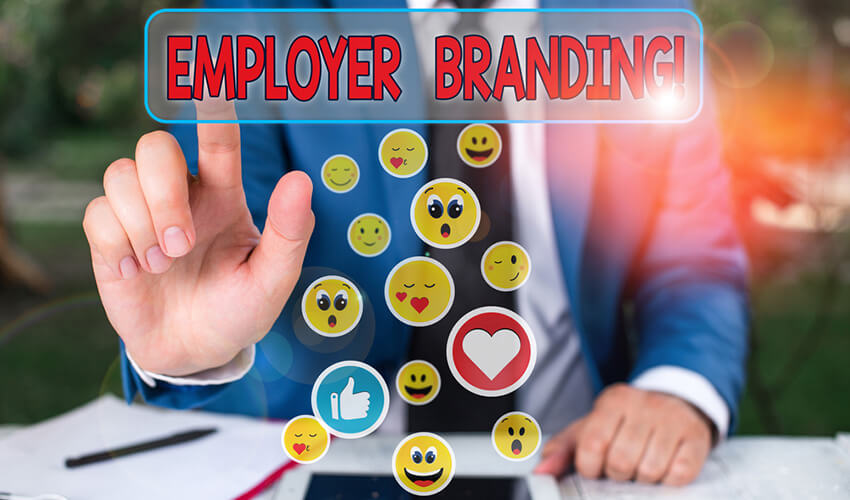The Essential Guide to Employer Branding in 2020
What Is Employer Branding?
You may be wondering what employer branding has to do with you. Well, the truth is that as a job seeker or team member of any company who will eventually have your brand, you need to know how an organization brands itself and how this can affect both its employees and potential new hires. In today’s competitive market, companies need all possible tools at their disposal to attract talent to find someone qualified enough for the position. Employers don’t want more time wasted on unproductive applicants in this economy, and they would instead focus on those deserving candidates applying now!
Employer branding is about cultivating one single identity which projects an organization’s values onto its audience.
Employer branding is crucial to the recruitment process. Your employer brand can have an outsized impact on your ability to attract talent, so you should consider it when going about this all-important task. TA teams are best served by taking the time to understand what they’re trying to convey and how that will affect potential candidates in deciding whether or not this company would make a good fit with them based on those values.
Employer brand has been found as being one factor among many which impact TA’s abilities when seeking out new hires; but there seems to be some disagreement about its importance versus other factors like salary, work-life balance, etcetera: “Some might argue that compensation packages take precedence over things such as diversity initiatives—
How Do You Develop a Strong Brand?
Your employer brand will not be successful if it does not align with the company’s core values. As Straightline chairman Michael Watras writes, “The problem with most employer branding is that it becomes disconnected from the corporate brand and its core drivers.” This article takes a look at what makes an effective Employee Branding strategy.
Consistent branding is crucial to the success of any organization ̶ employees who are unfamiliar with your company may not buy into it if they’re never exposed. A good team member marketing campaign should reflect on-brand content for potential new hires or customers alike to see why this job would make them happy while enjoying our benefits package.
Defining your business’ brand is a process that begins with examining the core elements of a company’s mission, values, and vision. Ask yourself if you have found a way to translate these things externally in an effective manner or not yet? Certain companies do this well: for example when they explore what makes their company great from both angles – internally as employees and outwardly as potential employers with every communication channel imaginable (from corporate websites to social media platforms).
The strongest employer brands create continuity across all channels, which includes answering questions like “what is it about our culture that attracts top talent?” The key lies in finding ways to externalize those reasons so consistently into everything we communicate.
More than half of job seekers rely on social media and company websites to gather information about their prospective employers in the modern day. Strong messaging is key in ensuring you make a great first impression with your audience so that they’re confident enough to apply for one of your openings! And this isn’t just beneficial on an individual level – it also has many benefits when looked at from a business perspective. LinkedIn data proves that outstanding branding leads not only to increased qualified applicants but much faster hiring turnover as well!
Best Practices: The Big Picture
Employers should focus on building a talent dimension as part of the company brand, not an “employer” or “human resources” label. The ideal employer-brand strategy is a robust recruitment and retention tool for human resource professionals. Employers with the best brands can quickly find qualified candidates, increasing job opportunities without going through rehiring cycles constantly. One of the most effective ways to build a solid employer-branding strategy is by creating an environment that fosters team member happiness. Employees are more likely to be committed and productive when they’re happy at work, which can only happen if management takes their needs into account from day one – even with entry-level positions in mind!
For Watras, what has been called the ’employer brand’ should grow out of established company brands. Employers in today’s competitive market need all the tools at their disposal when attracting talent to ensure they find someone qualified enough for the position. If not, let’s say employers do not want more time wasted on unproductive applicants vying for jobs.
Talent is the lifeblood of every company. So to help build a future-proof workforce, you should first establish your talent framework for employees and potential hires alike. Management must understand what they’re looking for in their workers for this process, so make sure everyone on a team takes part – from executives down to administrative assistants who never see direct customer feedback firsthand! And when drafting up these guidelines? Remember the expectations placed on us at work and how that directly affects our home life. Remember to take care of yourself, too!
Trending Best Practices
In the fifth installment of their webinar series, TA Today’s panelists discussed how to navigate life in this economic downturn best. Employer branding and candidate messaging were two strategies they elaborated on that would help when looking for work during tough times like these. Employers need to take advantage of these tough times by advertising what they have available at lower prices than usual with an exclusive incentive anyone unemployed or under-employed. Job seekers are stressed out enough without spending time scrolling through job ads just waiting for employers that meet all qualifications; find me the perfect match!
To compete with companies that are paying less, they need to start thinking about ways they can stand out from other businesses. One way is by creating an appealing brand image through internal company culture and outward-facing sets of messages directed at potential employees or customers.
In the wake of Trump’s recent presidency, many companies are struggling to adapt. But there is still hope for those who take precautions and play their cards right: such as Bacardi and Gap. They’ve shown how they’re taking care of employees during a difficult time by providing resources like disaster relief funds or charitable donations to organizations that support communities impacted by natural disasters–which shows just what kind’. What’s more, these companies have continued with business as usual while also engaging in thoughtful dialogue about immigration reform—a topic we can all agree on! Other companies should follow suit if they want people working at their company long-term.
What You Can Do to Improve Best Practices
To increase engagement with our company, we should publish pictures of employees around the office or at an event. These will be moments that show how they are adapting to a new environment and help them feel more connected. Share what’s happening within your business, too–how you’re taking care of your employees? How has it shifted production or helped out in the community? Please take a look at how we’ve brought people together through these difficult times as well! Focus on team member experience: ‘How have you been supporting us during this difficult time?’ This will reflect positively on our employer brand for years down the line. We thank all those who continue working hard day-in and day-out with diligence despite setbacks so far away from home.
Referral Programs
Jennifer Newbill, the director of Global Employer Brand at Dell Computer, says that when employees refer their networks to your company, it’s likely you are doing something right. Referred workers have a higher rate of staying with companies, and they enjoy working there because they believe in its mission. Furthermore, referrals provide an essential litmus test for how well branded your organization is – if referred members stay longer than other hires who were not guided by current employees, then this speaks volumes about branding success.
Employers with strong employer brands, like Dell, believe that not only are employees often the best recruiters but also that their employer brand is a narrative. The company’s story starts and ends at its people; they value each individual and invest in them to ensure they grow into all-star contributors.
Be quick: Don’t delay recognizing referrals or when you hire a referred candidate because both of these actions will go on for years as an team member tells stories about what it was like working there – good or bad! Say thank you for any referral by following up personally (and quickly!) instead of just sending out automated emails, which can end up thanking someone who may have never made contact again after submitting information online.
Consider rewarding all qualified candidates with a referral: Yes, successful referrals of those hired should be rewarded but reward employees for referring people you weren’t able to hire. Former employees and retirees can also provide valuable connections in the industry, so don’t forget about them as potential sources for talent!
Take Advantage of Social Media
One way to keep in touch with old colleagues is by connecting on social media.
Social networking has become an integral part of the modern world, and it’s a primary source for interactions between your company and its former employees. You can’t do much about this if you’re not interested in staying connected, but there are options out there!
In this digital age, it’s expected that you would get negative reviews on websites like Glassdoor. You may be wondering how to turn lousy feedback into good publicity for your brand. Well, the number one rule is don’t go online! One thing we recommend at New Leaf Public Relations for our clients? Be transparent about what went wrong when things go south–instead of just sweeping them under the rug as some employers might do.
What are some strategies for handling negative social media comments?
Here’s what you should do: Don’t take it personally, always respond and thank the reviewer for their feedback (even if there is a disagreement), offer to have a face-to-face conversation about any concerns they may be having so that we can address them thoroughly. If someone makes false accusations or violates confidentiality agreements on your company’s behalf, then consult with HR and legal departments as this will require more serious attention. Lastly, pay equal attention to positive social media mentions, which come in handy when counterbalancing negativity found online!
Conclusion
A strong employer brand is the backbone of any successful business. It helps retention, attracts qualified candidates, and boosts overall performance, all while lowering costs for you as a company. In addition to that, recruiting top talent through your employer branding also strengthens your existing employees by integrating them into your organization’s culture, which will help sustain it in the long run too!




